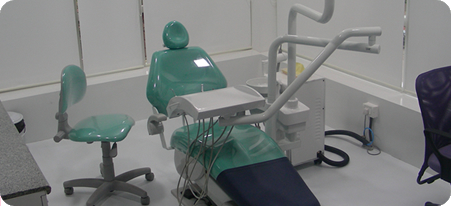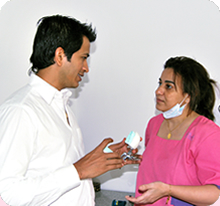|
 |
| |
| |
| Q. |
What is tooth bleaching? |
| A. |
Tooth Bleaching Is a procedure where by certain bleaching agents are applied to the teeth for lightening stains or discoloration of your teeth. |
| |
|
| Q. |
What is involved in tooth bleaching? |
| A. |
Dentists can determine which bleaching method is right for you. They will either use an in-office bleaching system or laser bleaching during your dental care visit. But, most patients choose dentist-at-home-supervised bleaching. This method involves a custom-made mouth guard for the patient along with bleaching materials. You will be given instructions on how to wear the mouth guard and this type of method generally required ten to fourteen days to complete. |
| |
|
| Q. |
What is smile designing? |
| A. |
A good smile involves in it more than just healthy teeth and gums. It is a blend of symmetry, color, shape and lines that create a balanced harmonious smile. Many of us have good and healthy teeth as well as gums but are yet unhappy with our smiles. In such an instance we can go in for a smile evaluation to an esthetic dentist who will evaluate the smile for its missing, predominant or underplayed features and then proceed with their correction through various means. This procedure is called Smile Designing. |
| |
|
| Q. |
There's a big gap between my two front teeth. Can that be corrected? |
| A. |
Yes. Veneers can close gaps (diastema) and help create the smile you desire. Bonded resins generally require one office visit, while porcelain veneering takes two. Veneers, along with good oral hygiene and a healthy lifestyle, are effective ways to enhance a smile. A cosmetic dentist can explain the various techniques and help determine which is the best suited to your specific needs. |
Periodontal / Gum Disease
| Q. |
Does cleaning of teeth make them loose? |
| A. |
Teeth will not become loose because of the cleaning procedure. The teeth are held firmly in place due to the gums and the bone around them. The tartar gathered around the teeth causes infection of the gums and bone. This infection leads to receding of bone and gum levels and thus creates gaps between teeth. This tartar if not removed periodically (once in every 6 months) can cause loosening of teeth. The cleaning procedure will help remove tartar and stop the gum and bone from receding. |
| |
|
| Q. |
Why do my gums bleed? |
| A. |
There could be various reasons why one would face a problem of bleeding gums like accumulation of tartar around the necks of teeth, using a hard bristle tooth brush, intake of certain medications like anti-epileptic drugs. It calls for immediate attention by a dental professional to detect the cause and suggest suitable treatment options. |
| |
|
| Q. |
What do I do to get rid of bad breath? |
| A. |
Bad breath or halitosis is a common problem which could be prevalent not only due to dental problems but also some systemic diseases like diabetes, stomach upsets etc. Bad breath can arise due to negligence of oral hygiene, pyorrhoea in gums, food lodgement in decayed teeth, unclean tongue. You could be either suggested the use of a mouthwash, taught proper brushing/flossing techniques and /or treated for dental decay or gum problems. |
|
|
Children's Teeth
| Q. |
Why do children get cranky when they are teething? |
| A. |
Yes children do get cranky when teething since they may experience the signs like drooling, irritability, restlessness, and loss of appetite. Fever, illness, and diarrhoea are not symptoms of teething. If your child presents with the latter signs, they need to be evaluated by your doctor. The best solution to comfort the child is to have the child chew on a cold or frozen rubber teething ring. Topical anesthetics/ gels are NOT advisable. |
| |
|
| Q. |
How can a Dentist Protect your child’s teeth? |
| A. |
As a child’s permanent teeth erupt, the Dentist can prevent cavities from forming with the help of sealants and Flouride treatment. |
| |
|
| Q. |
What are dental sealants? |
| A. |
Dental sealants are a plastic coating painted on the grooved, hard-to-reach surfaces of the back teeth. Pits and fissures on these surfaces are particularly susceptible to tooth decay. Dental sealants can be used to seal out cavity-causing bacteria from damaging the teeth. |
|
|
Implants
| Q. |
What are implants? |
| A. |
These are titanium tooth supports, which are surgically fixed into the jaw to replace missing teeth. Once embedded into the bone, they serve as supports to the crown and bridge by taking support from the bone and not from the adjacent teeth and hence do not require trimming of any adjacent teeth for replacement of missing teeth. |
| |
|
| Q. |
Who is a good candidate for dental implants? |
| A. |
Nearly anyone who is missing one or more teeth, and desires a superior, long-lasting aesthetic result is a good candidate for dental implants. However, patients must have enough bone to support and stabilize the implant. Some individuals who have suffered bone loss as a result of gum disease or another condition may need bone grafting before a dental implant can be placed successfully. |
General
| Q. |
What causes sensitive teeth? |
| A. |
Sensitive teeth can be caused by a range of factors. The porous part of the tooth, called dentin, is the region that registers pain, and dentin can become exposed due to:
- Fractured or chipped teeth
-
Teeth injured by clenching or grinding
-
Receding gums caused by gum disease or improper brushing
|
| |
|
| Q. |
How can sensitive teeth be managed? |
| A. |
Pain from sensitive teeth often comes and goes, but if you experience constant pain, you may have a more serious problem.
There are many effective treatments for sensitive teeth, including:
- A soft-bristle toothbrush to prevent gum irritation
-
Toothpaste designed to insulate the nerve that registers pain
-
A fluoride rinse or gel. |
| |
|
| Q. |
If I am missing one or more teeth, what are my options? |
| A. |
Patients today have an array of options for replacing missing teeth. Dental bridges, dentures, and dental implants all have their advantages and disadvantages, though modern cosmetic and restorative dentistry has come to favor dental implants because they look and function just like real teeth and require no special care. |
| |
|
| Q. |
What Is root canal treatment? Is it painful? |
| A. |
Root Canal treatment is advised in cases where the nerve within the tooth is affected either due to decay, trauma or fracture. It involves the removal of the damaged or diseased pulp or nerve, cleaning and shaping the root canal and subsequently filling the canals with a suitable material. This treatment is done under anesthesia and hence painless. |
| |
|
| Q. |
Which toothpaste is ideal for use? |
| A. |
All toothpastes work as foaming agents that help to clean your teeth of plaque and food remnants. The choice of most toothpastes is governed by their medicinal content and flavour. Any fluoridated toothpaste is a good general toothpaste for the family. Medicated toothpastes are available for specific purposes and should be used under the advise of your dentist only. |
| |
|
| Q. |
What do you do when you have a toothache? |
| A. |
When you have a toothache, you should clean your mouth by rinsing with warm water and remove any food that is trapped between teeth by flossing. Do not apply aspirin on the aching tooth or gum tissues. See your dentist as soon as possible. |
|
| |
|
|
|
|
 |
|
 |
| |
| |
Educational Open Days : Open to the Public |
|
| |
Smiles By Zahra regularly invites members of the public to a series of open evening on the following topics:
- Non-Invasive Dentistry
-
Painless smile makeovers
-
Lumineers
-
Dental Implants
-
Teeth in an Hour
-
Teeth Whitening
-
Dental Wellbeing |
|
|
|
|
|
|
|
|
|